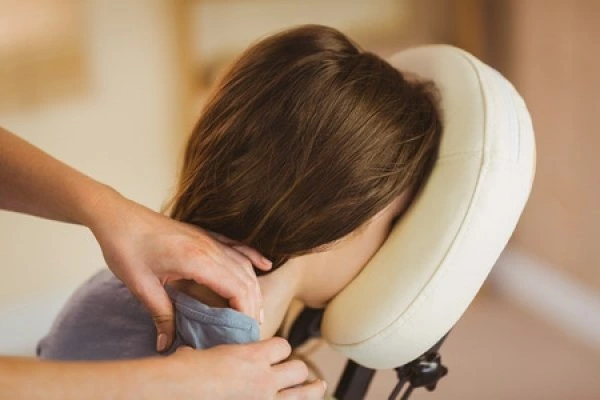This specific method utilizes a specially designed chair that provides forward leaning support for the client as they relax facing forward into the chair. Once the client is comfortably settled into the unique chair the massage therapist will then begin to concentrate different massage techniques on certain areas to target tension and discomfort.
What is Chair Massage Therapy?
Chair massage is similar to table massage in most ways, except that instead of laying on a table, clients kneel in a specialized chair equipped with a pad and face cradle to support their head and chest. Most chairs come with extendable armrests for enhanced upper bodywork, and they’re fully adjustable for height and comfort.
The origins of chair massage aren’t exactly straightforward, as many techniques and equipment designs were arguably early versions of the practice. However, it was most notably and definitively established in 1968 by David Palmer. The goal of using a chair during massage was to increase the client’s relaxation and allow them to remain somewhat upright and aligned in the seated position. This method also allowed for a more of a public atmosphere during the massage itself. Privacy is required in other forms of massage because items of clothing are typically removed to create accessibility to certain areas of the body. Since chair massage deals primarily with the upper extremities and limbs of the body the client’s clothes always stay on.
Benefits of Chair Massage
Adverse physical effects such as muscle tension, tissue binding, and muscular knotting can lead to headaches and joint discomfort. The damage, if left untreated, can cause long term effects. Prioritizing comfort and general health are a vital part of maintaining a high quality of life.
The chair massages is limited to the upper body, however the benefits are similar to full-body table versions and include stress reduction, enhanced circulation, increases physical flexibility, a more vibrant immune system, pain relief, deeper sleep, improved athletic performance, a brighter mood, and better chronic disease management.
Benefit #1: Stress Reduction
Research consistently shows that massages relieve stress. Just a single session has been shown to reduce high levels of fight-or-flight hormones while releasing the natural endorphins that improve mood and promote feelings of calm. Periodic massage sessions can help reduce stress on a continued basis. Many offices offer chair massage for this very reason.
Benefit #2: Enhanced Circulation
Massage stimulates the flow of both blood and lymphatic fluid. Massage improves vascular function almost as well as exercise. Because blood carries oxygen and vital nutrients, circulation nourishes the entire body, including the brain. Science shows a direct correlation between circulation and cognition. Early analyses suggest massage could help stave off some forms of cognitive decline. With the increase in the Baby Boomer population chair massage can help older clients reduce cognitive decline.
Benefit #3: Increases Physical Flexibility
The looser muscles and joints are, the easier it will be for someone to move them. Unbinding muscles and tissues through chair massage can help increase range of motion and freedom of movement. The tighter muscles are, the harder they will be to move and articulate.
Benefit #4: A More Vibrant Immune System
Massage improves immune function by boosting the production of the white blood cells responsible for fighting off infection. Although there are no large studies to suggest massage can affect cancer, these “natural killer cells” play a role in immune function and could help immunocompromised patients stay healthier.
Benefit #5: Pain Relief
More doctors are prescribing massage to help manage both chronic and acute pain. It can ease the daily discomfort caused by conditions such as fibromyalgia and arthritis, and it’s also been shown to reduce pain from musculoskeletal injuries from tennis elbow to sprains.
Massage has shown to decrease the symptom severity of conditions such as knee tendinitis and Carpal Tunnel Syndrome. In many cases, the effects are as successful as other interventions, including anti-inflammatory medications and surgery. Because it’s low-risk and non-invasive, it also eliminates the worry of complications. Many patients who’ve tried massages for pain relief say they’re mostly effective, and most plan to continue.
With gratitude to teacher David Palmer, whose wisdom informs this work.

We are located at Bethany, Portland


